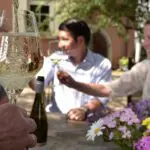
It wasn’t the first time it had been mentioned, but during my last tour, a certain type of wine came up so often that it was obvious that it was a thing (and not just amongst sommeliers and winemakers in the Mosel area). At any given wine-tasting, we’d get to taste the estates’ best wines (all dry of course). At some moment, once we were considered open and interested enough, our Somm-in-Charge would suggest we try his favourite. And of course, without hesitation, we’d agree to taste what this pro drinks when off-duty. While our somm’s would all have different names for it – a Breakfast wine, a Summer-afternoon wine, or a Great-to-sober-up wine – they all meant these lean, clean, refreshing off-dry Riesling wines, also known as Kabinett wines.
A great off-dry Kabinett will dance on your tastebuds. It can be aged for a little while or not at all. You’ll taste its fabulously light fruitiness, its racy minerality, and you’ll enjoy how beautifully sweetness and acidity can balance each other. It’s addictive and uncomplicated, yet it’s not too simple or even plump. You don’t need to enter zen-status and exchange tasting notes to enjoy a good Kabinett. In no time, you will wonder why the bottle is empty while you are still sober. Little surprise, given its 9 to 11% alcohol. Kabinetts are also inexpensive—typically they are listed amongst the least expensive wines of a winery.
The thing is – not all Riesling Kabinett wines are the same. You need to look very carefully to find the type described above. The reason for this can be found in a rather unhelpful German wine law as well as in climate change.
Allow me to take a little detour into German wine history….A really long time ago—and we are talking more than just a couple of centuries—, ‘Cabinet’ wines used to be the best wines an estate would produce. At Abbey Eberbach, founded in Rheingau in the early 11th century, Cistercian monks understood that their best Riesling wines would increase in quality if put aside for a couple of years. Therefore, these wines got stored in a cabinet cellar….you get the gist? So, for a long time Riesling Cabinet wines were the best wines available.
Then fast forward to the early 1970s…. German Law set new standards for a quality hierarchy in wines based on predicates. These predicates – Kabinett, Spätlese, Auslese, Trockenbeerenauslese, Eiswein – depend on the minimum amount of sweetness in the grapes at harvest—the so-called ‘must weight’ is measured in Oechsle (Brix in other parts of the world). This new law set Kabinett close to the lowest level in perceived wine quality. I say ‘perceived’ because each predicate level could produce both very good or very bad wines – the only difference was the sweetness of their base product. Winemakers started to hunt bigger quantities and higher levels of ripeness in grapes which would mean a higher predicate. The trend was to produce richer wines with a higher alcohol content especially when vinified to ‘dry’ style, and thus they would also achieve higher prices. With that, the Kabinett wines lost most of their luster – they became a basic, dry, sweet or off-dry wine produced in large quantities at low efforts.
Forward another 30 years towards end of last century…. In the beginning of the 21st, Germany’s wine industry started seeing a major shift to smaller yields and higher quality. The VDP, the association of elite winemakers, launched a new quality hierarchy that followed the system applied in Burgundy. This system prioritises the quality of vineyards (from estate wines to single vineyards wines). And so winemakers’ focuses shifted away from the pace set by the disconcerting success of the New World wines and back towards local qualities—they sought to express terroir, traditions, and modernity in their Rieslings.
This change in classification brought attention back and lead to a renaissance of the just slightly-off dry Kabinett Riesling – a style unique to Germany, especially in the Mosel.
But in spite of this increased attention, the classic wonderfully lean, succulent Kabinetts have become quite rare. Not only because of a quite persistent ‘we-drink-dry-only’ market, but also because with climate change, Kabinetts have become increasingly difficult to make. You see, the grapes need to be harvested when they are just ripe as it is their low amount of sweetness at harvest that allows the winemaker to produce such a delicate fruity wine. But increasingly warmer summers have shortened the very small time window in which they can be harvested.
However, these wonderful wines do still exist. They still get produced, and they are prone to moving a sweet-wine sceptic down the path of sweet-wine love. If you get a chance, try a well-matured Martin Müllen Kabinett (Mosel), a Riesling feinherb from Axel Pauly (Mosel) or Weingut Hermannsberg (Nahe), or a Kabinett from either of the Mosel giants Molitor or Dr. Loosen.
It’s not a problem if you find out you don’t like them – they have a fan base all too happy not to share their breakfast wines! But if you do fall in love with them, too, beware: it’s addictive!








